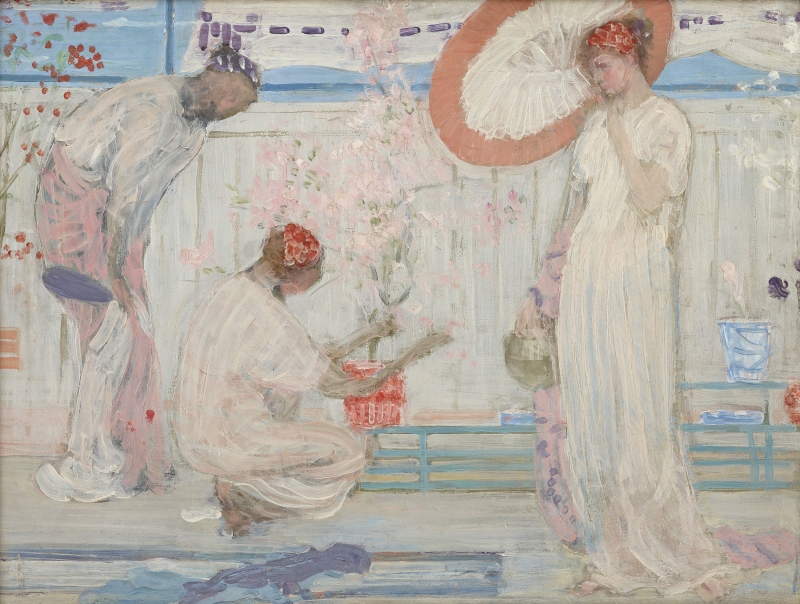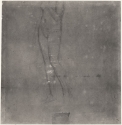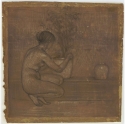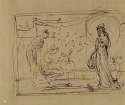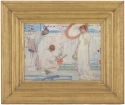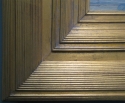Home > Catalogue > Browse > The White Symphony: Three Girls << >>
Composition
DRAWINGS:
Two possible early studies are A crouching woman in a short-sleeved robe [M.0325] and A woman listening to a musician [M.0328]. Both show draped figures. A woman listening to a musician [M.0328] is similar in pose to the standing figure on the right but lacks the accessories of jug and parasol, and the draperies are different: however, it shows that the pose was one to which Whistler frequently returned. Most extant studies date from slightly later than this and show nude figures.
A nude holding up a parasol [M.0372] shows a possible alternative pose for the standing figure at right, with the woman's right hand stretched out to a railing, and the parasol, held in her right hand, behind her head (further right than in the oil sketch).
In Nude with parasol [M.0371] (private collection) the woman has both hands under her chin, one clutching the jug (which in the oil sketch is down by her side) and the other the parasol. This drawing is not only hard to date but was sold at auction as by Albert Joseph Moore (1841-1893) in 1989. 1 It has since been re-attributed, but illustrates how close is the relationship between Whistler's work and Moore's, as was recognised by the artist and others at the time (the Daily News commented in 1887 that the oil sketch looked like 'an unfinished Albert Moore'). 2
Another drawing (with an identical title), Nude with parasol [M.0373] (seen above), is closer to the final pose, with her right hand at her side holding what might be interpreted as a jug, but here the soft outlines of the figure suggest the drawing was reworked at a later date. Variations on the pose are seen in other late drawings, the most elaborate being Parasol; red note [M.0957], which started as a nude figure in 1884, and was fully clothed by the 1890s.
Several of the early studies for the nude with the parasol are on the back of other drawings. 3 It is likely that these studies survived because the other side of the paper was used for later drawings. Most of them are difficult to date. For instance, r.: A Japanese Woman; v.: Girl with parasol [M.0458] was dated ca 1872 on the strength of the Japanese figure on the recto, but in fact the Girl with Parasol dates from some time earlier. Pinholes in the paper suggest that it was pinned up for reference more than once but it is impossible to tell which of the two sides was being consulted.
One sheet dating from 1869/1870 contains two drawings: r.: Crouching figure in 'The White Symphony: Three Girls'; v.: Standing figure in 'The White Symphony: Three Girls' [M.0359]. It has a partial sketch of the standing figure on one side, and an elaborately finished one of the central figure on the other. This crouching figure appears to have taken on a life of its own. Later drawings deriving from the pose include The Lily [M.0364] (where the figure faces left, the rounded pot has orange spots, and the flower is a white lily), r.: Studies for a portrait; v.: Study of crouching figure [M.0688], A crouching nude tending a flowering plant [M.1389], and the gorgeous Rose et argent: Fleurs de printemps [M.1391], dating from the early 1890s.
The figure on the left also had a prolonged after-life. There are numerous drawings, some of which could well be studies for a closely related drypoint, Tillie: A Model [113], which is dated 1873. These include Tillie [M.0367], Study of a Nude [M.0368], Study for 'Tillie: A Model' [M.0369] and Tillie: Study in Pink and Mauve [M.0370]. Some of these were reworked later; Tillie: Study in Pink and Mauve was completed and signed in 1890.
Thomas Robert Way (1861-1913), who was in and out of Whistler's studio in the late 1870s, wrote later, 'I saw at least three distinct variations in oil sketches, and an immense number of drawings of the various figures in black and white and pastel on brown paper, some in the nude, some with drapery added.' 4
A pen drawing of the whole composition differs in several details from the painting. The flower pot in the centre has round rather than straight sides. The woman at right has a more obvious round jug in her right hand, and the parasol frames her head in a large circle, rather than being tilted towards the left (her right). There is a swathe of material hanging behind the straight line of fence behind the figures, in the drawing, where, in the painting, there appears to be an awning above and behind the fence. The drawing is signed with a butterfly on a rectangular cartouche, and must therefore date from after 1871, and probably from 1873 or 1874 when the oil sketch was exhibited in London. It may also represent a proposed, unrealised development of the composition.
THE PAINTINGS:
The White Symphony: Three Girls [YMSM 087] is a study for The Three Girls [YMSM 088] of which only a fragment, known as Girl with Cherry Blossom [YMSM 090], survives. The composition of the destroyed painting, The Three Girls [YMSM 088], is known from a copy made by Whistler, Pink and Grey: Three Figures [YMSM 089].
The White Symphony: Three Girls [YMSM 087] differs in many details from the copy of the whole composition, Pink and Grey: Three Figures [YMSM 089]. The left-hand figure in the sketch is draped, and holds a fan, but in the copy she is nude. In the sketch, the right-hand figure is holding a basket, which does not appear in the copy. The central, crouching, figure in both The White Symphony: Three Girls [YMSM 087] and Girl with Cherry Blossom [YMSM 090] is reaching out with both hands to the right of the main stem of the shrub in the pot, but in Pink and Grey: Three Figures [YMSM 089] her right hand just reaches the edge of the pot and the other hand is not seen.
There are considerable signs of reworking and alterations. Under the bending figure there is a figure crouching even lower, with her arms straight down, and the purple drapery in front of her was further to the right. The parasol originally came further left, and to the left of it, the blinds hung in a single deep curve.
Technique
It was painted on a dark grey ground on coarsely textured millboard. It was freely painted with a medium-sized brush and shows a variety of techniques. There is palette knife work on the blossoms, and the branches of the shrub in the centre have been scratched with the knife, or the wrong end of the brush. The faces of the women have been worked with the fingers. The paint is of a creamy consistency, and the brushstrokes throw up a ridge of colour on each side, particularly on the robes. The bright pastel colours criss-cross freely, contrasting with the dark board underneath. At a late stage, the background was painted up to and round the figures. The paint on the blossoms at right has dripped down.
The Freer website comments:
'This study for The Three Girls represents the early, optimistic stage of Whistler’s work on the painting that Leyland commissioned ... Whistler painted The White Symphony on millboard, a coarsely textured, inexpensive support appropriate for creating a rough draft of the composition.' 5
Conservation History
For some time Whistler had five of the 'Six Projects' hanging in his house in Cheyne Walk. In June 1892 they were cleaned and varnished by Stephen Richards (1844-1900), his picture restorer in London. Whistler then asked David Croal Thomson (1855-1930) to retrieve them from Richards and send them to him immediately in Paris, 'I want my small pictures that you gave him to clean and varnish - You know the ones I mean - the sketches that used to hang in the dining room, Cheyne Walk.' 6
However, when they arrived he wrote to Richards from Paris:
'I have just received the five small paintings on millboard - (sketches of figures & sea) - that you have cleaned & varnished for me. They look pure and brilliant as on the day they were painted! -
But while you were about it, I wish enough you had seen to the condition of their backs - They were put down upon other cardboards some time ago, and they are all loose and bent about now … How could you let them leave your place, clean and freshly varnished as they were, unframed! ... However happily they are unharmed.' 7
Treatment at the Freer Gallery of Art included being cradled, cleaned and resurfaced in 1931, resurfaced in 1942, and cleaned and surfaced in 1951.
Frame
- 1874/1889: the style and whereabouts of any early frame is unknown.
- 1890/1892: possibly framed in a Grau-style or other frame of unknown type, whereabouts unknown.
- 1903/1917: Grau-style, American-made, after 1903 [17.8 cm]. 8
It was exhibited in 1874 and 1887 & 1904 (wonder if there are pictures from this event?). So it may have had a reeded cassetta frame with painted decoration. Most likely this frame dates from Freer’s purchase or gift in 1919. Similar construction as the other frames on the 'Six Projects'.
For some time between 1890 and 1892 Whistler had the so-called 'Six Projects' (actually five!) hanging in his house in Cheyne Walk, although they were not exhibited. The five ' Projects' were certainly framed by 1892, when they were cleaned and varnished by Stephen Richards (1844-1900), but returned to the artist, as he complained 'without their frames? ! !' 9
The current Grau-style frame could have been added between 1892, when the painting was owned by Whistler, and its sale in 1903 or after it was bought by C. L. Freer in 1903. It is of similar construction to the frames on the other 'Projects'. It was certainly on the frame by 1904, as seen in the photograph above.
The frame was re-gilded in 1960.
Notes:
1: Sotheby's, London, 14 June 1989 (lot 376).
2: Daily News, London, 26 November 1887, press cutting in GUL Whistler PC9, p. 13. Similarly another critic said: 'Mr. Whistler’s principal picture seems to have been the result of a temporary desire to emulate Mr. Albert Moore, but after an hour’s blocking-in, the attempt was abandoned, and the result is such a daub as would certainly never be accepted by any other gallery.' Anon., 'Royal Society of British Artists', Hampshire Independent, 3 December 1887, press cutting in GUL Whistler PC9, p. 37.
3: r.: Inspiration; v.: A nude with a parasol and a jug [M.0358], r.: Crouching figure in 'The White Symphony: Three Girls'; v.: Standing figure in 'The White Symphony: Three Girls' [M.0359], r.: A Japanese Woman; v.: Girl with parasol [M.0458].
5: Freer Gallery of Art website at http://archive.asia.si.edu/exhibitions/current/lost-symphony/object.asp?id=Fig-12.
8: Dr Sarah L. Parkerson Day, Report on frames, 2017; see also Parkerson 2007 [more].
9: Ibid.
Last updated: 23rd November 2020 by Margaret

